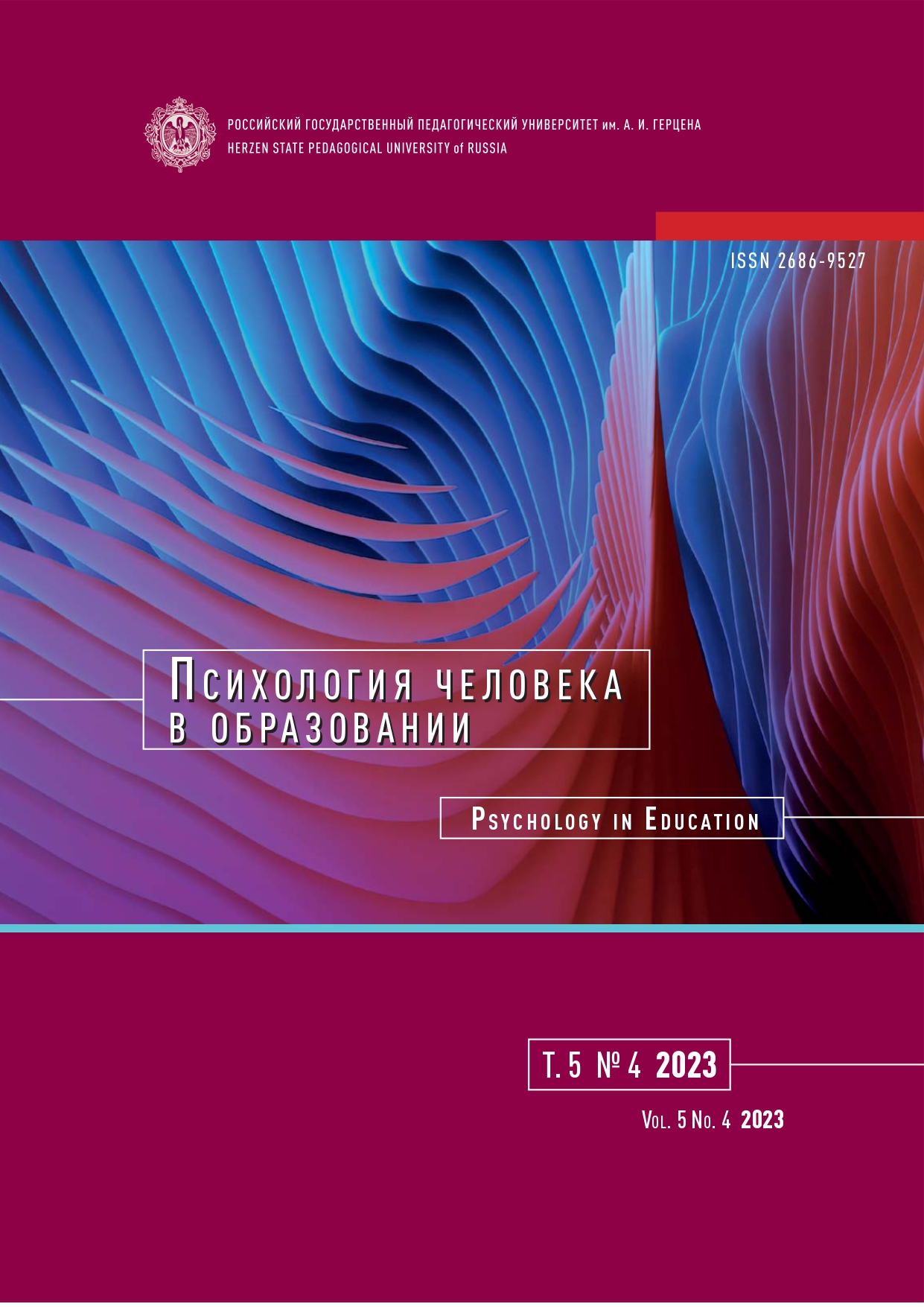Math anxiety in primary school teachers: Impact on teaching practice and classroom environment
DOI:
https://doi.org/10.33910/2686-9527-2023-5-4-512-518Keywords:
math anxiety, primary (elementary) school teachers, math performance, attitude towards mathematics, math anxiety transmissionAbstract
Introduction. In recent years, math anxiety and its impact on mathematical development has been high on the research agenda due to its significant effect on students’ math learning productivity. However, not only students are prone to math anxiety. Studies have shown that math anxiety can be found in teachers. Moreover, it prevails among pre-service and in-service primary (elementary) school teachers. It is a matter of serious concern since math anxiety in children appears as early as in primary school. The formation of children’s math skills and attitudes towards math in the first years of formal education strongly depends on the primary school teacher. If the teacher experiences anxiety towards math, this can negatively affect students’ math performance.
Materials and Methods. This article presents a brief review of foreign publications focusing on math anxiety among primary school teachers.
Results. The article discusses possible mechanisms of math anxiety development and its cause-and-effect relationship with math performance. The main focus is given to a teacher’s role in students’ propensity for math anxiety and lower learning outcomes. The article discusses how math anxiety among primary school teachers might contribute to their students’ negative experiences of mathematics. The review provides examples of empirical research that discusses the prevalence and causes of math anxiety among in-service and pre-service teachers.
Conclusions. Overall, studies show that math anxiety among teachers is often the result of their own experience of negative interactions with teachers, the use of ineffective teaching approaches and low level of mathematical competence. Summarizing the results of the studies, one can pay attention to the so-called cycle of unintentional transmission of math anxiety from teachers to students, which needs to be addressed at various levels.
References
Beilock, S. L., Gunderson, E. A, Ramirez, G., Levine, S. C. (2010) Female teachers’ math anxiety affects girls’ math achievement. Proceedings of the National Academy of Sciences of the United States of America, vol. 107, no. 5, pp. 1860–1863. https://doi.org/10.1073/pnas.0910967107 (In English)
Brady, P., Bowd, A. (2005) Mathematics anxiety, prior experience and confidence to teach mathematics among pre-service education students. Teachers and Teaching, vol. 11, no. 1, pp. 37–46. https://doi.org/10.1080/1354060042000337084 (In English)
Dowker, A., Sarkar, A., Looi, C.-Y. (2016) Mathematics anxiety: What have we learned in 60 years? Frontiers in Psychology, vol. 7, article 508. https://doi.org/10.3389/fpsyg.2016.00508 (In English)
Dutton, W. H. (1951) Attitudes of prospective teachers toward arithmetic. The Elementary School Journal, vol. 52, no. 2, pp. 84–90. https://www.jstor.org/stable/998089 (In English)
Gresham, G. (2018) Preservice to inservice: Does mathematics anxiety change with teaching experience? Journal of Teacher Education, vol. 69, no. 1, pp. 90–107. https://doi.org/10.1177/0022487117702580 (In English)
Hembree, R. (1990) The nature, effects, and relief of mathematics anxiety. Journal for Research in Mathematics Education, vol. 21, no. 1, pp. 33–46. https://doi.org/10.2307/749455 (In English)
Kelly, W. P., Tomhave, W. K. (1985) A study of math anxiety/math avoidance in preservice elementary teachers. The Arithmetic Teacher, vol. 32, no. 5, pp. 51–53. https://doi.org/10.5951/AT.32.5.0051 (In English)
Maloney, E., Beilock, S. L. (2012) Math anxiety: Who has it, why it develops and how to guard against it. Trends in Cognitive Science, vol. 16, no. 8, pp. 404–405. https://doi.org/10.1016/j.tics.2012.06.008 (In English)
McAnallen, R. R. (2010) Examining mathematics anxiety in elementary classroom teachers. PhD dissertation (Philosophy). Connecticut, University of Connecticut, 126 p. (In English)
Olson, A. M., Stoehr, K. J. (2019) From numbers to narratives: Preservice teachers experiences’ with mathematics anxiety and mathematics teaching anxiety. School Science and Mathematics, vol. 119, no. 2, pp. 72–82. https://doi.org/10.1111/ssm.12320 (In English)
Ramirez, G., Gunderson, E. A., Levine, S. C., Beilock, S. L. (2013) Math anxiety, working memory, and math achievement in early elementary school. Journal of Cognition and Development, vol. 14, no. 2, pp. 187–202. https://doi.org/10.1080/15248372.2012.664593 (In English)
Ramirez, G., Shaw, S. T., Maloney, E. A. (2018) Math anxiety: Past research, promising interventions, and a new interpretation framework. Educational Psychologist, vol. 53, no. 3, pp. 145–164. https://doi.org/10.1080/00461520.2018.1447384 (In English)
Raymond, A. M. (1997) Inconsistency between a beginning elementary school teacher’s mathematics beliefs and teaching practice. Journal for Research in Mathematics Education, vol. 28, no. 5, pp. 550–576. https://doi.org/10.2307/749691 (In English)
Wang, Z., Hart, S. A., Kovas, Y. et al. (2014) Who is afraid of math? Two sources of genetic variance for mathematical anxiety. The Journal of Child Psychology and Psychiatry, vol. 55, no. 9, pp. 1056–1064. https://doi.org/10.1111/jcpp.12224 (In English)
Wood, E. F. (1988) Math anxiety and elementary teachers: What does research tell us? For the Learning of Mathematics, vol. 8, no. 1, pp. 8–13. (In English)
Published
How to Cite
Issue
Section
License
Copyright (c) 2023 Alsu V. Shakmaeva, Anna A. Adaskina

This work is licensed under a Creative Commons Attribution-NonCommercial 4.0 International License.
The work is provided under the terms of the Public Offer and of Creative Commons public license Creative Commons Attribution 4.0 International (CC BY 4.0).
This license permits an unlimited number of users to copy and redistribute the material in any medium or format, and to remix, transform, and build upon the material for any purpose, including commercial use.
This license retains copyright for the authors but allows others to freely distribute, use, and adapt the work, on the mandatory condition that appropriate credit is given. Users must provide a correct link to the original publication in our journal, cite the authors' names, and indicate if any changes were made.
Copyright remains with the authors. The CC BY 4.0 license does not transfer rights to third parties but rather grants users prior permission for use, provided the attribution condition is met. Any use of the work will be governed by the terms of this license.







